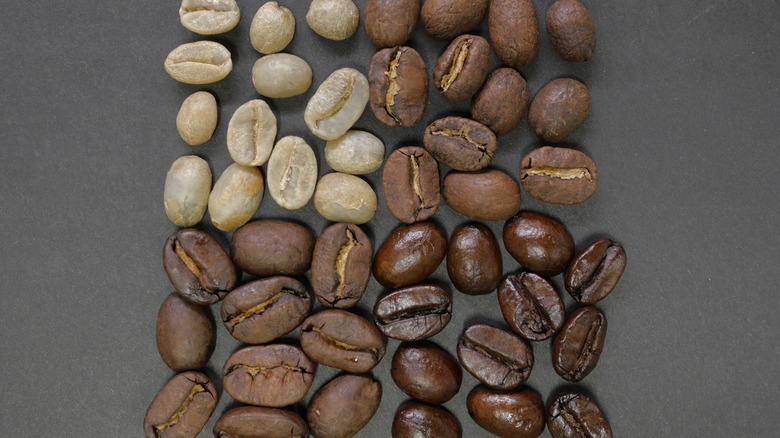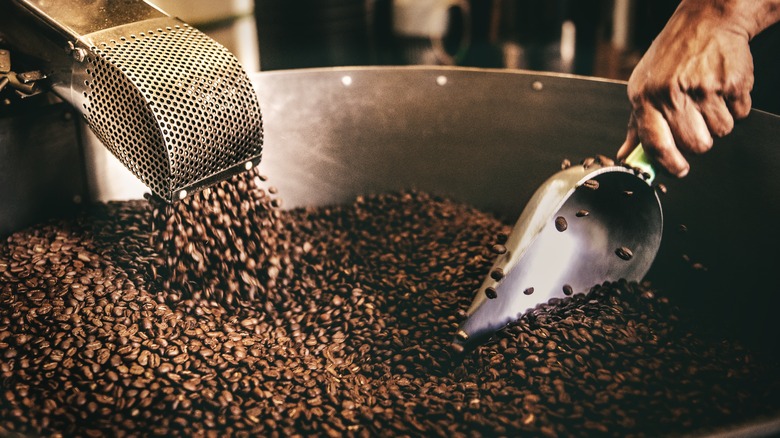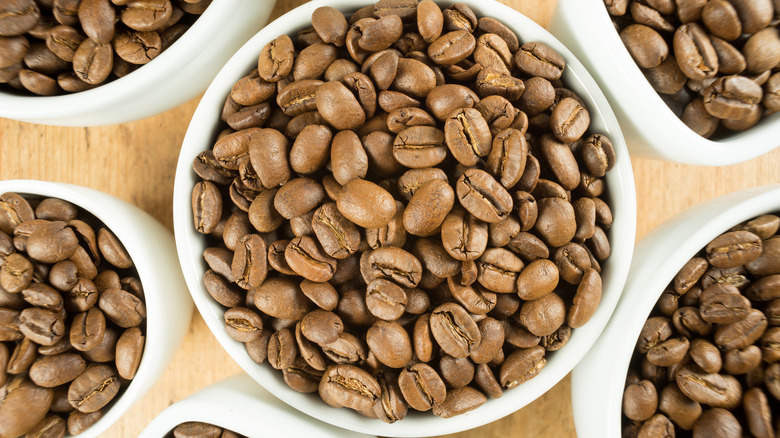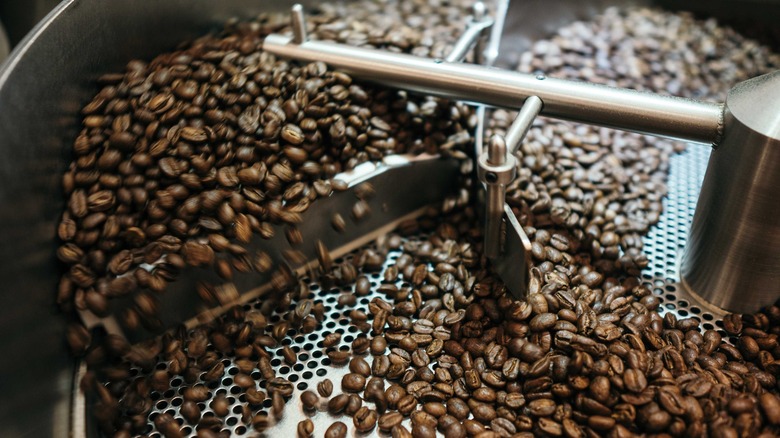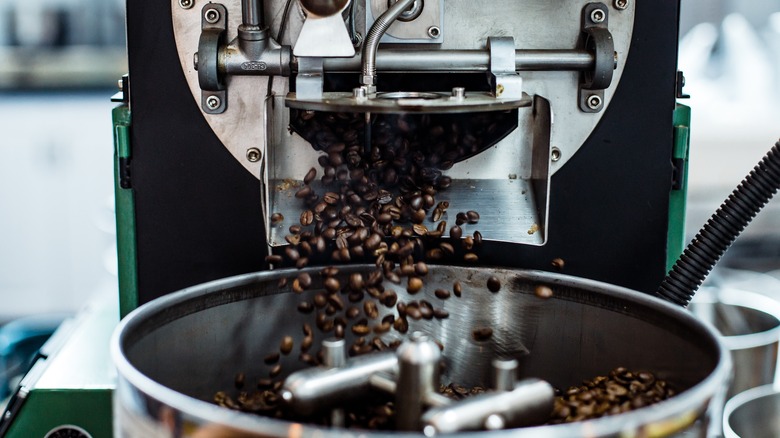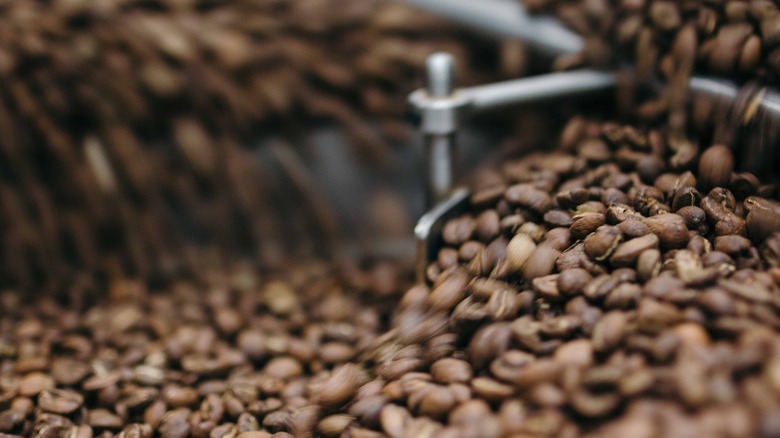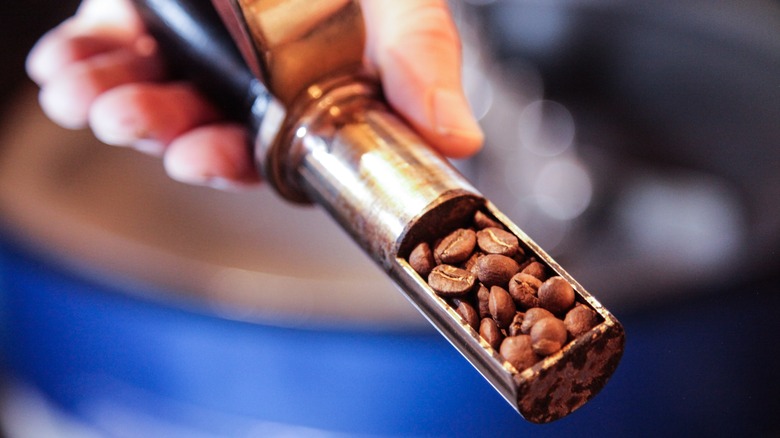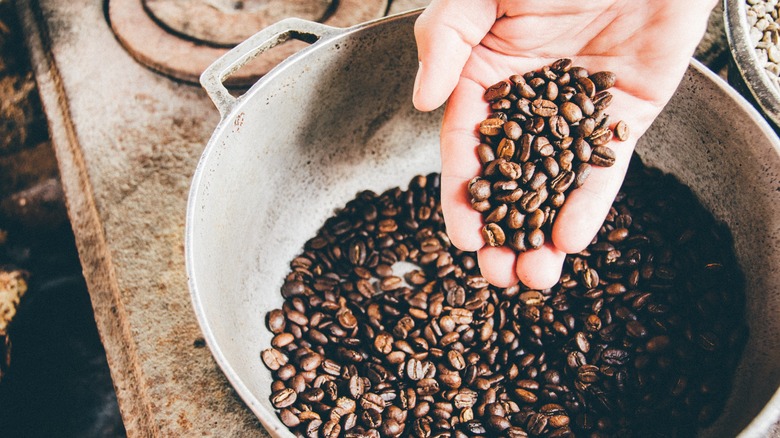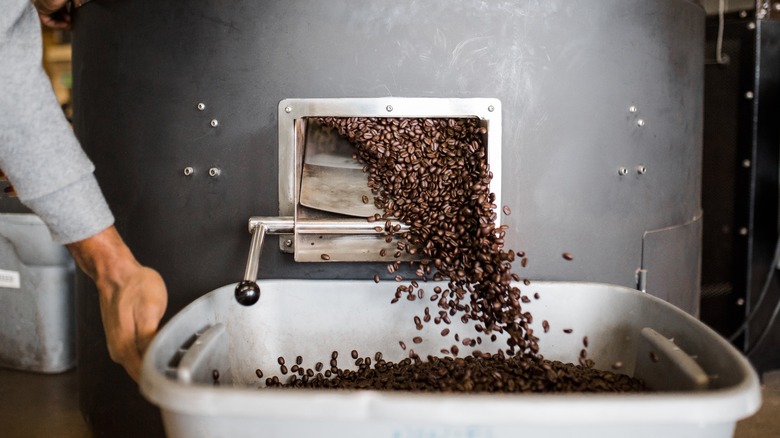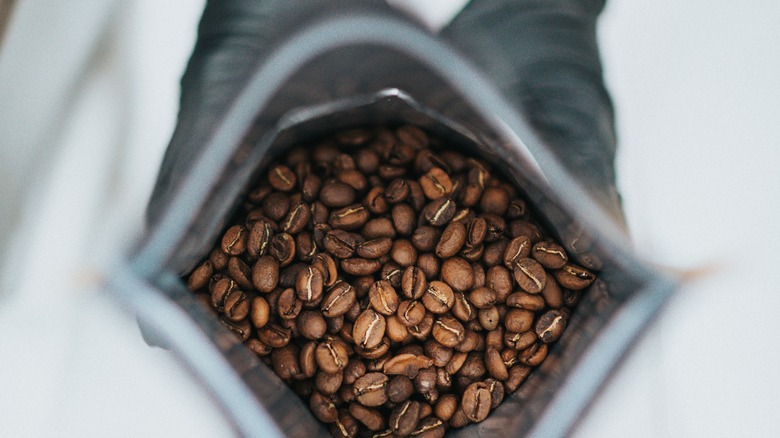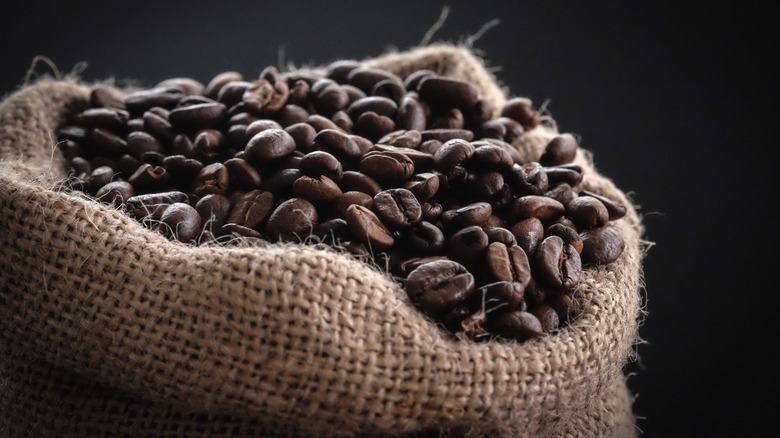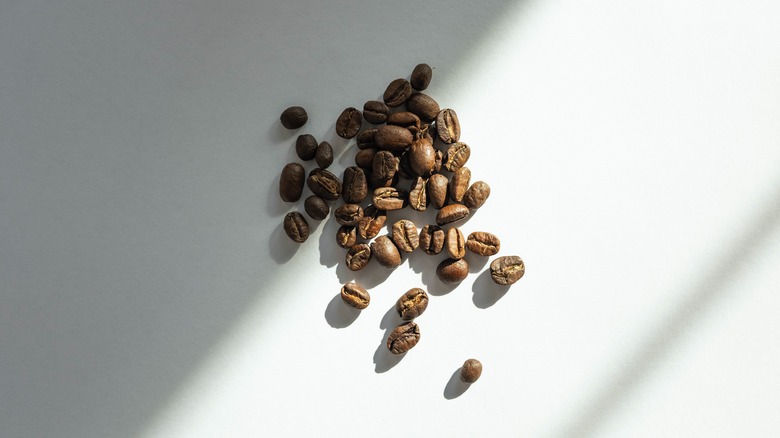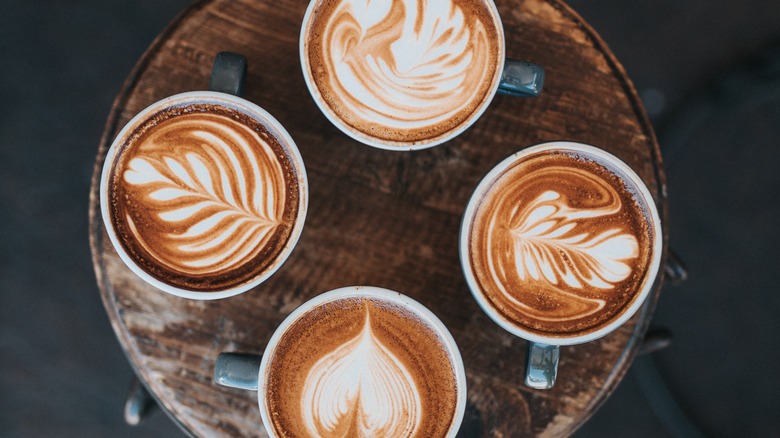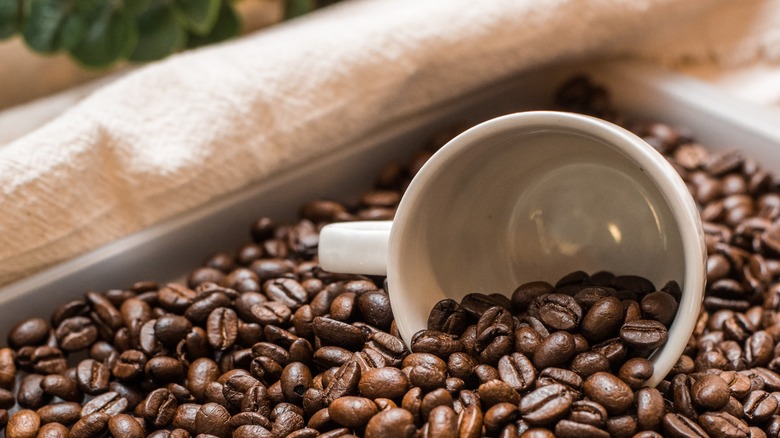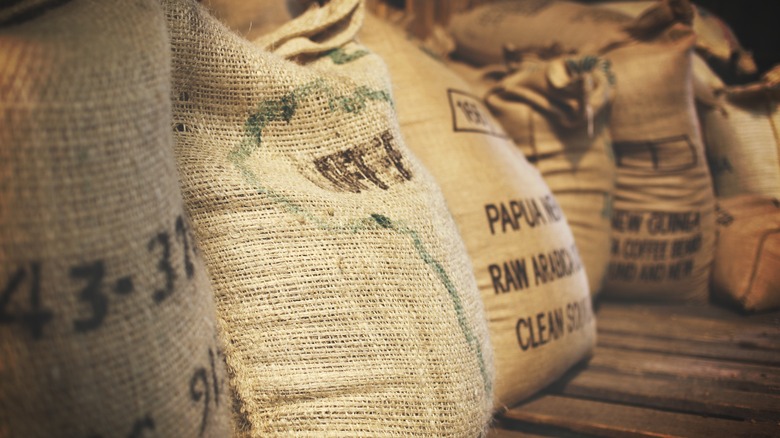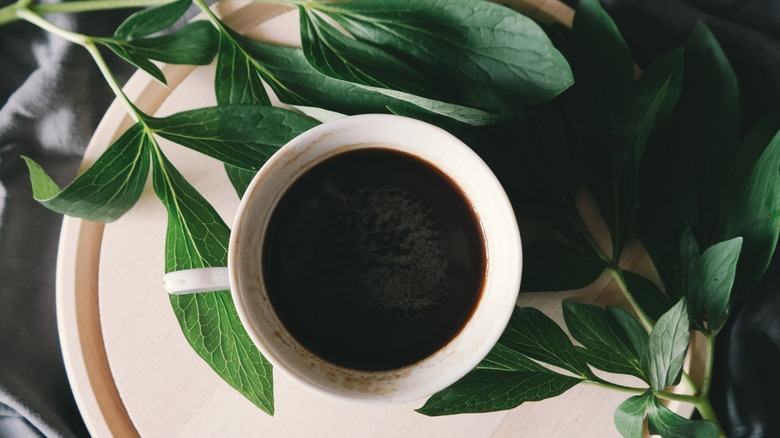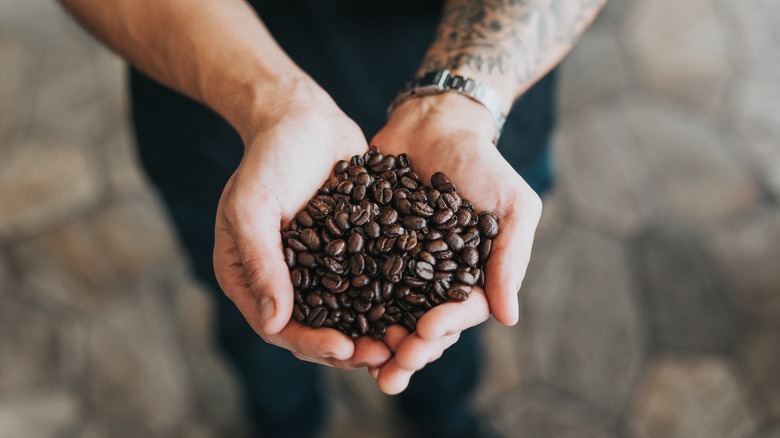16 Types Of Coffee Roasts, Explained
We may receive a commission on purchases made from links.
Some coffee lovers make an artisan espresso each morning, some brew a quick Keurig cup before dashing out the door, and some pay visits to their favorite cafe drive-throughs on their daily commute. Have you ever switched coffee brands or had coffee at a friend's house and been surprised to discover an entirely different flavor at the first sip? Some of this is can be credited to the brewing method, the age of the beans, and even the quality of water, but the roast of the beans might be the most influential factor in coffee flavor.
Unroasted coffee beans (usually referred to as green coffee) have an earthy flavor. Raw beans are bright green and dull with no oil on the surface, with a tightly-sealed cleft. When the beans are roasted, the water inside them begins to boil and turns into steam; the pressure created softens the rigid casing. Once the pressure reaches a peak, the walls will, essentially, explode, creating a cracking sound familiar to anyone who's observed roasting coffee. As the beans are roasted longer and the sugars and acids within the beans undergo chemical reactions, the flavor transforms. There are four general categories of coffee roast: light, medium, medium-dark, and dark. However, these roasts break down to even more minuscule distinctions, which are a blast to explore if you're looking to expand your coffee palate. Here's your comprehensive roadmap to coffee roasts.
Cinnamon roast
Coffee experts generally refer to cinnamon roast as the point where coffee becomes drinkable. For a cinnamon roast, beans are pulled at the very first sound of cracking (when the pressure builds up in the beans and sounds like exploding popcorn kernels), around 350 degrees Fahrenheit. Because of the high acidity in this barely-roasted coffee, it has the sourest and most citrusy flavor, retaining much of the intricate coffee fruit flavor that is lost as roasting goes on but also will taste more floral and grassy than more widely-consumed coffees.
There are health claims to light roasts like the cinnamon roast, namely, the evidence that suggests higher levels of antioxidants, notes the Journal of Medicinal Food, are in light roasts. These beans will look very light brown (the color of cinnamon, hence the name) and dry on the surface, meaning no oil has been excreted.
Keep in mind that cinnamon roast is very rarely sold in retail environments because of its low popularity — one of the only options we could find is the Whole Foods Market Smooth Operator Cinnamon Roast on Amazon. Should you give cinnamon roast coffee a try? If you consider yourself a voyager of coffee, sure, but if you're just looking to jazz up your everyday routine, probably not. Cinnamon roasted beans don't roast for a long enough time at high temperatures to see sucrose caramelization, which means your cup of coffee will be absent from the rich brown-sugar-like flavor evident in beloved medium roasts.
Blonde roast
Blonde roasts have been around for a while, but awareness of this roast increased when Starbucks launched its blonde espresso. In actuality, Starbucks' blonde is closer to a city roast, which is a medium roast, according to Drink Golden Ratio. To reach this roast, beans are essentially lightly toasted to just before the first crack, in the neighborhood of 350-to-375 degrees Fahrenheit. The resulting beans are slightly tanned, matte in texture, and produce quite sour and acidic coffee. You're likely to notice punchy tangs of grapefruit, wine, and citrus, as all the naturally occurring compounds responsible for coffee's terroir — or authentic flavor based on the soil, climate, and region they were grown in — have not been cooked away.
Would you enjoy having a cup of true blonde roast every day? For the majority of everyday coffee lovers, probably not. Generally speaking, most of us desire some degree of caramelization in our coffee beans, as it mellows out the terroir and brings a slight sweetness. However, if you're interested in bright coffees that vary widely in taste between different origins, you'll delight in exploring blonde roast coffee, which you can find through specialty and online retailers like Amazon.
Light City or New England roast
When you split hairs on the coffee roasting scale, you are likely to have some overlap and some roasts that go by multiple names, since there is no industry-wide standard when it comes to roasting monikers. This is the case with light city, half city, and New England roasts, which all fall in the light-roast jumble. Light city and New England are often used interchangeably and describe coffee beans that have been cooked to 375-to-400 degrees Fahrenheit.
Light city/New England roast coffees taste bright, delicate, fruity, and floral. The hay-like flavor evident in cinnamon roasts has been cooked away, leaving behind the truest flavor notes of the coffee cherry itself. This roast is pulled slightly after the first crack begins, so the beans will still appear very light brown; a touch darker than cinnamon roasts. There will be no oil visible on the beans, but the chaff — also called silverskin, this is the outermost green skin that is cooked off the longer beans roast — will be largely present in the cleft of the bean, looking like a little yellowish-gold river. Per bean, this is one of the most caffeinated roasts (next to raw and cinnamon).
While still not as common as seeing a coffee package that simply says "light roast," it is possible to locate light city or New England roast coffee (Trader Joe's we're looking at you). But will you enjoy it? If you prefer milder, brighter coffees, you'll enjoy light city.
Half City roast
For a fruity and flowery brew without the sour acidity of under-roasted beans, give the half city roast a try. The temperature to which the beans are roasted will vary based on the roaster's arbitrary preferences, but it'll more than likely be around 400-to-415 degrees Fahrenheit. This is the last of the light roasts, as anything roasted to a temp over 400 degrees Fahrenheit will be considered a medium roast. It's your last chance to get the tangy taste of coffee cherry and the highest caffeine content per bean, but the rich chocolatey notes of a coffee that's had time for its sucrose to caramelize will likely not be a strong flavor yet. The beans will still be a light brown color and matte texture — close to the end of the first crack.
Is half city roast palatable for the average coffee drinker? Certainly. This is a standard light roast that, in our experience, will have a soft floral overtone and lemony zip no matter the origin or brew of the beans. You're not likely to see half city on any grocery store coffee packaging, but this roast is available through specialty coffee outlets (Happy People Coffee) if you want to give the most robust of light roasts a try.
American roast
American roast has some overlap with half city and city — it's considered done at a temp of around 410 degrees Fahrenheit. At this roasting level, coffee beans have just begun to develop their rich chocolatey brown color, transitioning out of the pale cinnamon shade. However, no oils have likely cooked through to the surface of the bean yet, and the silverskin will still be strongly prevalent in the cleft of the bean. A widely popular choice among roasters because of its favorability by consumers, American roast is a light-medium roast that allows clear notes of the coffee's authentic flavor without adding any of the smoky flavors that occur as the roasting goes on.
This roast is a difficult one to not enjoy if you're a coffee fan. The brew begins to take on a more balanced mouthfeel and beans from different origins — like Rwanda, Ethiopia, and Kenya — will begin to take on unique flavor profiles for the everyday coffee drinker's palate. American roast coffee is somewhat accessible; it may be available on grocery store shelves, but you're more likely to find it through specialty roasters or online retailers, like the Glory Days American Roast by Whole Foods Market via Amazon.
City roast
If you pull your beans out of the roaster between 415 degrees Fahrenheit and 425 degrees Fahrenheit, you'll have yourself a nice city roast. We've now entered the medium roast territory, and your brews here are going to taste complex, warming, and familiar. Medium roasts are considered the best of both worlds between bright, punchy light roasts and velvety, rich dark roasts. At this roast, the first crack has been fully completed. Your coffee beans are in prime territory, about halfway between the first and second cracks; the caramelized flavor profile is developing, but the compounds responsible for the true flavor of the coffee bean have not yet been entirely cooked away. While still in the medium territory, darker roasts than this one exist for those who want a more robust, smoky coffee.
Where can you get city roast coffee, and should you get it? This roast is another that's not all that common to see on everyday shelves — even if the beans are roasted to the city level, the coffee is more than likely to be labeled as "medium" to remain familiar for the average coffee drinker. However, if you want to give pure city roast a try, there's the Coffee Bean Direct Brazilian Santos City Roast on Amazon.
Breakfast roast
Breakfast roast, also commonly seen as breakfast blend, is perhaps the most open to interpretation among the coffee community. Some roasters consider breakfast to be a light roast, while others identify it as a medium roast — truly, the breakfast roast lives somewhere in between. Because a blend of coffee beans (meaning coffee sourced from multiple farms, regions, or countries) is often used for breakfast, the flavor profile is likely to vary greatly by the brand of beans you purchase. Its place on the scale of doneness makes the breakfast roast a versatile and easy-to-drink brew that appeals to a wide range of coffee drinkers, which is said to be the reason for its name (as in easy to enjoy with your breakfast). It's more than likely the roast of choice for a cup of Joe poured for you at your local diner, and is often referred to as regular roast.
While it doesn't have a surefire place among light or medium roasts, the breakfast roast is a few moments after the first crack — it could be pulled anywhere between 410-to-430 degrees Fahrenheit depending on the roaster. It's a toasty-brown, matte bean with a moderately acidic but still balanced flavor. Breakfast blend/roast will be easy to find on grocery store shelves and through online retailers; coffee name brands like Green Mountain, Folgers, and Starbucks all offer breakfast roast coffees.
Full City roast
After the first crack in a coffee roast is complete, coffee beans only have about three or four minutes before the second crack. In those few moments, the beans' taste and appearance can undergo significant transformations. The color melts into a rich cocoa brown, and patches of oil begin to bloom on the surface of the bean as it cooks through the outermost skin. Slightly between the two cracks is a full city roast — this is a temp of around 435-to-440 degrees Fahrenheit. This roast is still in the territory where the origin of the beans will play a huge role in the final coffee's taste since medium roasts enhance coffee's natural flavors the most.
As we fall from medium roasts to dark roasts, this is where lovers of bold, full-bodied coffees will find their favorite brews. The coffee's acidity has started to drop, replaced by smooth sweetness. At this stage, you're most likely to notice flavors of chocolate, caramel, hazelnut, or toffee. Also known as full medium or light French, this is the most intense and least caffeinated of the medium roasts. It's still quite an easy coffee for most drinkers to palate each morning, but you may not see it on your grocery store shelves unless you shop at a specialty store; Whole Foods Market offers a full city roast, and we recommend this one by San Diego Coffee.
Continental roast
As we transition to medium-dark and dark roasts, around 440 degrees Fahrenheit, the coffee beans have started their second crack. At this point, coffee roasters must closely monitor the beans, as each second will edge them closer to being overdone and tasting burnt. These beans are deep brown, oily, and the visible silverskin is disappearing. Continental roasts are usually the first in line in the scale of medium to dark roasts; a smoky, caramel-like body is distinct in the flavor, but we aren't yet experiencing the burnt heaviness of the darkest roasts. Some also call the continental roast the "after dinner" roast because its decadent, vivacious mouthfeel makes for a great nonalcoholic nightcap.
We're approaching the coffees that are less likely to be daily morning brews of choice for most coffee drinkers; not only is the continental less caffeinated per bean than light and medium roasts, but the flavor is also just a bit too intense to take on first thing in the morning. However, if tart and fruity coffees have turned up your nose before, you may appreciate medium-dark roasts more. Medium or dark roast blends on grocery store shelves may include some continental roast, but to try it in pure form, it's better to look for the roast through online retailers like Amazon.
High roast
Hot on the heels of the continental roast is the high roast — and actually, these two terms are sometimes used interchangeably. The term high roast is somewhat vague and can be used in combination with other names, like Italian high roast, medium-high roast, or French high roast. However, the high roast is a few degrees further along in the roasting process than the continental, around 445 degrees Fahrenheit. At this point, the natural tones and original flavors of the coffee — referred to as the terroir, or the character developed by the combination of sunlight, altitude, climate, soil, and other growing conditions — have been overtaken by the flavors of the roaster's mastery.
On the darker side of medium-dark, high roast beans will appear dark brown and oily. The gold sliver in each bean's crack, the silverskin, is almost entirely cooked away. This roast is still not the darkest on the scale, though, so it could be a comfortable daily drinker for some coffee fans. The coffee on your local grocer's shelves is not likely to be labeled as a high roast, but you'll be able to find it with specialty retailers like the Maldon Coffee Company.
New Orleans roast
Some coffee roasts are named after the region where they first gained popularity — such as the New Orleans roast or blend, a Louisiana take that slightly lightens the French roast to a medium-dark degree. The New Orleans roast isn't distinguished by its degree of doneness, which is similar to a continental or full city depending on the individual roaster's approach. A point of confusion is New Orleans roast/blend vs. the New Orleans style coffee, which is traditional coffee that's been brewed with chicory root, and some say that the New Orleans roast is simply a dark roast combined with chicory.
A New Orleans roast embodies the flavor of dark coffee without all the elements that we could do without; no burnt or bitter taste, or greasy, heavy mouthfeel. Depending on where you live, you may find brands like the Community Coffee New Orleans Blend on the shelf — however, if you really want to caffeinate like NOLA, we recommend giving chicory coffee a try.
Espresso roast
Contrary to what some may believe, espresso is not made from a special type of coffee plant. It's also no more caffeinated than normal coffee beans; espresso is made by forcing hot water at a high speed and pressure through beans to extract the most caffeine possible into a small volume, just a few fluid ounces. This means that when roasters are making espresso beans they are simply doing so in a way that optimizes the beans' taste as espresso.
Roasters have the challenge of finding the degree of doneness where the ideal amount of grounds will dissolve easily and quickly for an espresso shot while maintaining a flavor-balanced taste that's not too sour or acidic. A darker roast will achieve both; more cooked beans will dissolve in water easier and produce a less acidic flavor. Too dark, however, and the terroir of the coffee will be lost in overdone bitterness. Espresso roast is not exclusive to other roasts — meaning an espresso roast may also be a full city or a Vienna roast, too.
How can you make espresso at home? Besides a professional espresso machine, a Nespresso machine, Moka pots, and Aeropress contraptions are affordable ways to make the intense, concentrated base for lattes and cappuccinos. Starbucks has a solid espresso roast, but the Lavazza Super Crema Medium Espresso Roast is our recommendation.
Viennese roast
Viennese roast coffee is usually a dark reddish-brown in color as the beans begin to take on the purplish hue of the furthest end of the roasting spectrum. It's a full-bodied, low-acidity roast with a heavy mouthfeel and undercurrents of dark chocolate. This roast is considered to be somewhere between the beginning and middle of the second crack, around 445 degrees Fahrenheit. At this roast, your beans will appear quite oily with very little gold in the cleft.
Lighter than both French and Italian roasts, this may be the most tolerable dark roast for many consumers, making it a solid contender for daily morning drinking. However, many coffee lovers prefer dark roasts later in the day because of their more intense flavor and lower caffeine content. As we move into the darkest roasts, the sweetness of medium and medium-dark roasts will morph into bitterness as the sucrose progresses from caramelized to burnt. Vienna is a popular choice for espresso and milk-based drinks because the creaminess balances out the affront of powerful coffee. Vienna roasts are easy to locate on grocery store shelves and through online retailers; we recommend seeking a high-quality Kona origin bean for Vienna roasts, like Mountain Thunder.
European roast
On the dark end of the scale is European roast coffee, which is coffee that's been roasted extra dark and also typically ground extra fine. The European style of roasting is meant to create a smooth, low-acidity coffee that pairs well with charcuterie, crudité, and patisserie. There aren't hard boundaries for roasting temps for many of the dark roasts, as the temperature differences become more minuscule as the hottest possible temperature is reached, but this coffee is roasted to somewhere in the neighborhood of 465 degrees Fahrenheit, which is around the end of the second crack.
Traditionally, European roasters have always preferred to make a bold coffee — which is exactly what the extra-dark European roast is. The authentic European style of roasting beans is to do the process in small batches, slowly and carefully by hand, but specialized European roasting machinery exists too. To stand out and keep up with emerging trends and preferences, some overseas roasters have switched to and specialized in lighter roasts. Melitta is the leading producer of European roast coffee.
French roast
Most roasters agree that coffee is no longer usable once the beans have been roasted beyond 480 degrees Fahrenheit or even 485 degrees Fahrenheit. French roast is approaching this stopping point — but it's not quite there. Also called a double roast, this dark coffee is intense, smoky, and bittersweet. French roast coffee is roasted somewhere between the middle and end of the second crack, in the range of 465 degrees Fahrenheit and 470 degrees Fahrenheit. You'll recognize French roast beans by their bluish-purple glint over their very dark brown color, oily surface, and absent silverskin.
These darker roasts will feel slightly thinner and more watery than lighter roasts, with no lasting nuance of the coffee plant's natural flavor; the taste of charcoal and clove-like spice is entirely the product of the roaster's mastery and technique. For this reason, the origin or even quality of beans is considered to be less important for a dark roast. Some sweetness may linger, but the acidity has been nearly erased.
French roasts, beloved by dark coffee drinkers, are popularly used in a French press or even for drip coffee. It pairs well with heavy cream, which balances out the intensity of the roast, and we find it to be a good strong coffee for affogato drinks. Almost all brands offer their own variety of French roasts, but we recommend Stumptown Coffee Roasters.
Italian roast
Italy knows a thing or two about coffee, and they prefer theirs roasted dark. We're talking dark dark. Italians have been roasting coffee beans for centuries, first originating in the Venetian Republic where coffee was so beloved that it was blessed by the Pope (via Italian Tribune). Italian roast beans will look purplish-black and greasy, and all of the silverskins will have been cooked away. The coffee plant's natural flavors and terroir are going to be nearly impossible to discern for casual coffee drinkers if they are even still present at all.
There's a common misconception that these ultra-dark, ultra-bold roasts will give you more caffeine, but that is not the case. Coffee's natural caffeine content cooks away with time. More Americans prefer medium roasts than the all-business Italian roast, but this ultra-dark bean has a permanent place in coffee culture. Italian roasts are stopped at the end of the second crack, between 470 to 475 degrees Fahrenheit. Just five degrees further and the coffee beans would be considered burnt and unusable. The coffee is bitter with a dash of sweetness at best, taking on a strong smoky flavor and low acidity. You might enjoy the occasional cup of Italian roast in the afternoon or as the base for an espresso drink, but it is by far not the most popular choice for daily coffee drinking here in the United States. The Starbucks Italian roast can get you started, or check out Brooklyn Coffee for something new.
